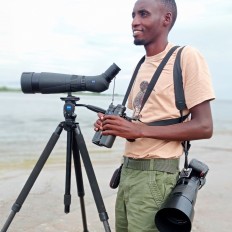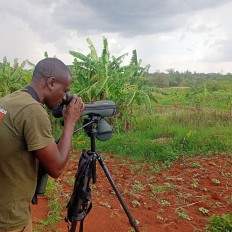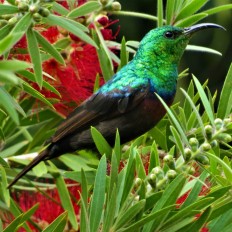Top species
- Chestnut-bellied Sandgrouse (Pterocles exustus)
- Black-faced Sandgrouse (Pterocles decoratus)
- Double-banded Courser (Smutsornis africanus)
- Temminck's Courser (Cursorius temminckii)
- Barn Owl (Tyto alba)
- Spotted Eagle-Owl (Bubo africanus)
- Verreaux's Eagle-Owl (Ketupa lactea)
- Pearl-spotted Owlet (Glaucidium perlatum)
- White-headed Mousebird (Colius leucocephalus)
- Fischer's Lovebird (Agapornis fischeri)
- Yellow-collared Lovebird (Agapornis personatus)
- Pygmy Batis (Batis perkeo)
- Taita Fiscal (Lanius dorsalis)
- Red-throated Tit (Melaniparus fringillinus)
- Spike-heeled Lark (Chersomanes albofasciata)
- Fischer's Sparrow-Lark (Eremopterix leucopareia)
- Fawn-colored Lark (Calendulauda africanoides)
- White-tailed Lark (Mirafra albicauda)
- Red-capped Lark (Calandrella cinerea)
- Somali Short-toed Lark (Alaudala somalica)
- Short-tailed Lark (Spizocorys fremantlii)
- Gray Wren-Warbler (Calamonastes simplex)
- Red-fronted Prinia (Prinia rufifrons)
- Singing Cisticola (Cisticola cantans)
- Ashy Cisticola (Cisticola cinereolus)
- Wailing Cisticola (Cisticola lais)
- Tiny Cisticola (Cisticola nana)
- Zitting Cisticola (Cisticola juncidis)
- Desert Cisticola (Cisticola aridulus)
- Banded Parisoma (Curruca boehmi)
- Pale White-eye (Zosterops flavilateralis)
- Hildebrandt's Starling (Lamprotornis hildebrandti)
- Spotted Morning-Thrush (Cichladusa guttata)
- Little Rock-Thrush (Monticola rufocinereus)
- Abyssinian Wheatear (Oenanthe lugubris)
- Beautiful Sunbird (Cinnyris pulchellus)
- Vitelline Masked-Weaver (Ploceus vitellinus)
- Speke's Weaver (Ploceus spekei)
- Black-faced Waxbill (Brunhilda erythronotos)
- Steel-blue Whydah (Vidua hypocherina)
- Kenya Rufous Sparrow (Passer rufocinctus)
- Long-billed Pipit (Anthus similis)
- Reichenow's Seedeater (Crithagra reichenowi)
- Southern Grosbeak-Canary (Crithagra buchanani)
List up to ca. 25 species that:
• have a limited distribution range and/or are rare on a global level
• are most sought-after by birdwatchers at this site
• and are relatively easy to see at this site (year-round or seasonally)
| Chestnut-bellied Sandgrouse (Pterocles exustus) | |
| Black-faced Sandgrouse (Pterocles decoratus) | |
| Double-banded Courser (Smutsornis africanus) | |
| Temminck's Courser (Cursorius temminckii) | |
| Barn Owl (Tyto alba) | |
| Spotted Eagle-Owl (Bubo africanus) | |
| Verreaux's Eagle-Owl (Ketupa lactea) | |
| Pearl-spotted Owlet (Glaucidium perlatum) | |
| White-headed Mousebird (Colius leucocephalus) | |
| Fischer's Lovebird (Agapornis fischeri) | |
| Yellow-collared Lovebird (Agapornis personatus) | |
| Pygmy Batis (Batis perkeo) | |
| Taita Fiscal (Lanius dorsalis) | |
| Red-throated Tit (Melaniparus fringillinus) | |
| Spike-heeled Lark (Chersomanes albofasciata) | |
| Fischer's Sparrow-Lark (Eremopterix leucopareia) | |
| Fawn-colored Lark (Calendulauda africanoides) | |
| White-tailed Lark (Mirafra albicauda) | |
| Red-capped Lark (Calandrella cinerea) | |
| Somali Short-toed Lark (Alaudala somalica) | |
| Short-tailed Lark (Spizocorys fremantlii) | |
| Gray Wren-Warbler (Calamonastes simplex) | |
| Red-fronted Prinia (Prinia rufifrons) | |
| Singing Cisticola (Cisticola cantans) | |
| Ashy Cisticola (Cisticola cinereolus) | |
| Wailing Cisticola (Cisticola lais) | |
| Tiny Cisticola (Cisticola nana) | |
| Zitting Cisticola (Cisticola juncidis) | |
| Desert Cisticola (Cisticola aridulus) | |
| Banded Parisoma (Curruca boehmi) | |
| Pale White-eye (Zosterops flavilateralis) | |
| Hildebrandt's Starling (Lamprotornis hildebrandti) | |
| Spotted Morning-Thrush (Cichladusa guttata) | |
| Little Rock-Thrush (Monticola rufocinereus) | |
| Abyssinian Wheatear (Oenanthe lugubris) | |
| Beautiful Sunbird (Cinnyris pulchellus) | |
| Vitelline Masked-Weaver (Ploceus vitellinus) | |
| Speke's Weaver (Ploceus spekei) | |
| Black-faced Waxbill (Brunhilda erythronotos) | |
| Steel-blue Whydah (Vidua hypocherina) | |
| Kenya Rufous Sparrow (Passer rufocinctus) | |
| Long-billed Pipit (Anthus similis) | |
| Reichenow's Seedeater (Crithagra reichenowi) | |
| Southern Grosbeak-Canary (Crithagra buchanani) |
Gray Wren-Warbler (Calamonastes simplex) was added by Isaac Kilusu (2021-02-04 10:27:55)
Black-faced Sandgrouse (Pterocles decoratus) was added by Isaac Kilusu (2021-02-04 10:26:54)
Chestnut-bellied Sandgrouse (Pterocles exustus) was added by Isaac Kilusu (2021-02-04 10:26:27)
Double-banded Courser (Smutsornis africanus) was added by Isaac Kilusu (2021-02-04 10:26:08)
Temminck's Courser (Cursorius temminckii) was added by Isaac Kilusu (2021-02-04 10:25:30)
Taita Fiscal (Lanius dorsalis) was added by Isaac Kilusu (2021-02-04 10:24:51)
Long-billed Pipit (Anthus similis) was added by Isaac Kilusu (2021-02-04 10:23:22)
Spotted Morning-Thrush (Cichladusa guttata) was added by Isaac Kilusu (2021-02-04 10:22:21)
Pale White-eye (Zosterops flavilateralis) was added by Isaac Kilusu (2021-02-04 10:21:32)
Reichenow's Seedeater (Crithagra reichenowi) was added by Isaac Kilusu (2021-02-04 10:21:10)
Banded Parisoma (Curruca boehmi) was added by Isaac Kilusu (2021-02-04 10:20:57)
Fawn-colored Lark (Calendulauda africanoides) was added by Isaac Kilusu (2021-02-04 10:20:23)
Kenya Rufous Sparrow (Passer rufocinctus) was added by Isaac Kilusu (2021-02-04 10:20:03)
Vitelline Masked-Weaver (Ploceus vitellinus) was added by Isaac Kilusu (2021-02-04 10:19:34)
White-tailed Lark (Mirafra albicauda) was added by Isaac Kilusu (2021-02-04 10:17:31)
Red-capped Lark (Calandrella cinerea) was added by Isaac Kilusu (2021-02-04 10:17:13)
Southern Grosbeak-Canary (Crithagra buchanani) was added by Isaac Kilusu (2021-02-04 10:16:37)
Black-faced Waxbill (Brunhilda erythronotos) was added by Isaac Kilusu (2021-02-04 10:16:03)
Steel-blue Whydah (Vidua hypocherina) was added by Isaac Kilusu (2021-02-04 10:15:38)
Speke's Weaver (Ploceus spekei) was added by Isaac Kilusu (2021-02-04 10:15:23)
Hildebrandt's Starling (Lamprotornis hildebrandti) was added by Isaac Kilusu (2021-02-04 10:15:09)
Beautiful Sunbird (Cinnyris pulchellus) was added by Isaac Kilusu (2021-02-04 10:14:50)
Yellow-collared Lovebird (Agapornis personatus) was added by Isaac Kilusu (2021-02-04 10:13:29)
Fischer's Lovebird (Agapornis fischeri) was added by Isaac Kilusu (2021-02-04 10:13:04)
Fischer's Sparrow-Lark (Eremopterix leucopareia) was added by Isaac Kilusu (2021-02-04 10:12:43)
Abyssinian Wheatear (Oenanthe lugubris) was added by Isaac Kilusu (2021-02-04 10:12:19)
White-headed Mousebird (Colius leucocephalus) was added by Isaac Kilusu (2021-02-04 10:11:55)
Little Rock-Thrush (Monticola rufocinereus) was added by Isaac Kilusu (2021-02-04 10:10:22)
Zitting Cisticola (Cisticola juncidis) was added by Isaac Kilusu (2021-02-04 10:09:55)
Desert Cisticola (Cisticola aridulus) was added by Isaac Kilusu (2021-02-04 10:09:40)
Tiny Cisticola (Cisticola nana) was added by Isaac Kilusu (2021-02-04 10:09:12)
Wailing Cisticola (Cisticola lais) was added by Isaac Kilusu (2021-02-04 10:08:19)
Ashy Cisticola (Cisticola cinereolus) was added by Isaac Kilusu (2021-02-04 10:07:48)
Singing Cisticola (Cisticola cantans) was added by Isaac Kilusu (2021-02-04 10:06:57)
Pearl-spotted Owlet (Glaucidium perlatum) was added by Isaac Kilusu (2021-02-04 10:06:11)
Verreaux's Eagle-Owl (Ketupa lactea) was added by Isaac Kilusu (2021-02-04 10:05:51)
Spotted Eagle-Owl (Bubo africanus) was added by Isaac Kilusu (2021-02-04 10:04:56)
Barn Owl (Tyto alba) was added by Isaac Kilusu (2021-02-04 10:04:34)
Red-fronted Prinia (Prinia rufifrons) was added by Isaac Kilusu (2021-02-04 10:04:13)
Pygmy Batis (Batis perkeo) was added by Isaac Kilusu (2021-02-04 10:03:45)
Somali Short-toed Lark (Alaudala somalica) was added by Isaac Kilusu (2021-02-04 10:03:03)
Short-tailed Lark (Spizocorys fremantlii) was added by Isaac Kilusu (2021-02-04 10:01:02)
Red-throated Tit (Melaniparus fringillinus) was added by Isaac Kilusu (2021-02-04 10:00:23)
Spike-heeled Lark (Chersomanes albofasciata) was added by Isaac Kilusu (2021-02-04 09:59:44)





